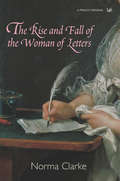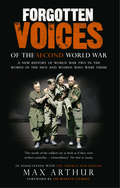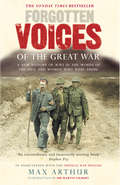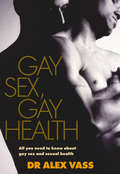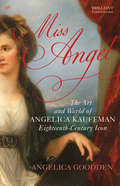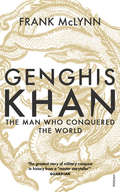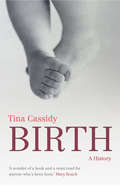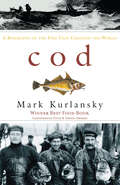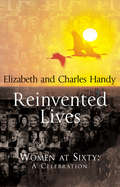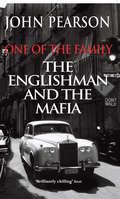- Table View
- List View
Civilization: A New History of the Western World
by Roger OsborneEver since the attacks of 11th September, western leaders have described a world engaged in 'a fight for civilization'. But what do we mean by civilization? We believe in a western tradition of openness and freedom that has produced a good life for many millions of people and a culture of enormous depth and creative power. But the history of our civilisation is also filled with unspeakable brutality - for every Leonardo there is a Mussolini, for every Beethoven symphony a concentration camp, for every Chrysler building a My Lai massacre. How can we come to the defence of a civilisation whose benefits seem so questionable? In this ambitious and important book Roger Osborne shows that we can only truly understand our civilization by re-examining and confronting our past, with all its glories and catastrophes. Sweeping in its scope and comprehensive in its coverage, Civilzation tells the story of the western world from its origins to the present. At such a dangerous time in the world's history, this brilliant book is required reading.
Significant Sisters: The Grassroots of Active Feminism, 1839-1939
by Margaret ForsterEight women who changed the worldCaroline Norton * Elizabeth Blackwell * Florence Nightingale * Emily Davies * Josephine Butler * Elizabeth Cady Stanton * Margaret Sanger * Emma GoldmanSignificant Sisters traces the lives of eight women, each of whom pioneered vital changes in the spheres of law, education, the professions, morals or politics: the first woman doctor, the pioneer of birth control, a radical journalist, and suffragists. Each forged her own particular brand of feminism, yet all fought bravely to make real, lasting difference to women's lives, and make us redefine our own notions of feminism today.
Good Wives: Mary, Fanny, Jennie And Me, 1845-2001
by Margaret ForsterWhat is a 'good wife'? The bestselling author of Hidden Lives explores four marriages, including her own, in different times and societies to find the answer.In 1848 Mary Moffatt became the wife of the missionary and explorer David Livingstone - and her obedience and devotion eventually killed her. In 1960, Margaret Forster married her school sweetheart Hunter Davies in a London Registry Office - and interpreted the role very differently. Between these two marriages is a huge gulf in which the notion of marriage changed immeasurably. Forster traces the shift in emphasis from submission to partnership, first through the marriage of one unconventional American, Fanny Osbourne, to Robert Louis Stevenson, in the late nineteenth century; and then through that of Jennie Lee to Aneurin Bevan in the 1930s. Why does a woman still want to be a wife in the twenty-first century? What is the value of marriage today? Why do couples still marry in church? These are some of the questions Forster asks as she weaves the personal experience of forty years through the stories of three wives who have long fascinated her.
Live Working or Die Fighting: How The Working Class Went Global
by Paul MasonGlobalisation has created a whole new working class - and they are reliving stories that were first played out a century ago. In Live Working or Die Fighting, Paul Mason tells the story of this new working class alongside the epic history of the global labour movement, from its formation in the factories of the 1800s through its near destruction by fascism in the 1930s and up to today's anti-globalisation movement.Blending exhilarating historical narrative with reportage from today's front line, he links the lives of 19th-century factory girls with the lives of teenagers in a giant Chinese mobile phone factory; he tells the story of how mass trade unions were born in London's Docklands - and how they're being reinvented by the migrant cleaners in skyscrapers that stand on the very same spot. It is a story of urban slums, self-help co-operatives, choirs and brass bands, free love and self-education by candlelight. And, as the author shows, in the developing industrial economies of the world it is still with us. Live Working or Die Fighting celebrates a common history of defiance, idealism and self-sacrifice, one as alive and active today as it was two hundred years ago. It is a unique and inspirational book.
Lost White Tribes: Journeys Among the Forgotten
by Riccardo Orizio Ryszard KapuscinskiOver three hundred years ago the first European colonialists set foot in Africa, Asia and the Caribbean to found permanent outposts of the great empires. This epic migration continued until after World War II when these tropical outposts became independent black nations, and the white colonials were forced, or chose, to return home. Some of these colonial descendants, however, had become outcasts in the poorest stratas of the society of which they were now a part. Ignored by both the former slaves and the modern privileged white immigrants, and unable to afford the long journey home, they still hold out today, hiding in remote valleys and hills, 'lost white tribes' living in poverty with the proud myth of their colonial ancestors. Forced to marry within the tribe to retain their fair-skinned 'purity' they are torn between the memory of past privileges and the present need to integrate into the surrounding society.The tribes investigated in this book share much besides the colour of their skin: all are decreasing in number, many are on the verge of extinction, fighting to survive in countries that alienate them because of the colour of their skin. Riccardo Orizio investigates: the Blancs Matignon of Guadeloupe; the Burghers of Sri Lanka; the Poles of Haiti; the Basters of Namibia; the Germans of Seaford Town, Jamaica; the Confederados of Brazil.
The Bottom Of The Harbor (Virago Modern Classics)
by Joseph MitchellAfter Joe Gould's Secret - 'a miniature masterpiece of a shaggy dog story' (Observer) - here is another collection of stories by Joseph Mitchell, each connected in one way or another with the waterfront of New York City. As William Fiennes wrote in the London Review of Books, 'Mitchell was the laureate of the waters around New York', and in The Bottom of the Harbor he records the lives and practices of the rivermen, with love and understanding and a sharp eye for the eccentric and strange. This is some of the best journalist ever written.
Shapely Ankle Preferr'd: A History of the Lonely Hearts Ad 1695 - 2010
by Francesca BeaumanWhat do women look for in a man? And what do men look for in a woman? And how and why has this changed over the centuries?Every week thousands of people advertise for love either in newspapers, magazines or online. But if you think this is a modern phenomenon, think again - the ads have been running for over three hundred years. In 1695, a popular London pamphlet published the brave plea of a young gentleman who 'would willingly Match himself to some Good Young Gentlewoman, that has a Fortune of £3000 or thereabouts'. This was just the beginning. In the 1730s, papers carried regular ads in which income or respectability were the most desired qualities, though some asked for a 'shapely ankle' or a 'non-dancer'. By 1900 twenty-five British newspapers were dedicated solely to matrimonial ads. Shapely Ankle Preferr'd tells the story of ads of all kinds - from aristocrats and MPs, bus conductors and nurses, country squires and city swells, and even from a man who had lost a leg 'due to the kick of an Ostrich, in the East Indies'. The reasons are strangely familiar: the size of the city makes it hard to meet people; they're busy at work; they've just returned from abroad. Loneliness is not new.The surprising views of Lord Byron, Charlotte Brontë and George Orwell are revealed, and every ad is a snapshot of its age, from the criminal scams of the 1890s to the sad appeals of widows after the Second World War. In this fascinating book Fancesca Beauman uses newly uncovered evidence to answer crucial questions about how humans choose their mates. The result is a startling history of sex, marriage and society over three centures - hilarious and heartbreaking by turn.
The Rise And Fall Of The Woman Of Letters
by Norma ClarkeIf Aphra Benn is widely regarded as the first important woman writer in English, who was the second? In literary history, the eighteenth century belongs to men: Pope and Swift, Richardson and Fielding. Asked to name a woman, even the specialist stumbles. Jane Austen? She didn't publish until 1811. Aphra Benn herself? She died in 1869.The Rise and Fall of the Woman of Letters tells the remarkable but little-known story of women writers in the eighteenth century - of poets, critics, dramatists and scholars celebrated in their own time but all but forgotten by the beginning of the new century. Eliza Haywood, Catherine Cockburn, Elizabeth Elstob, Delarivier Manley, Elizabeth Rowe, Jane Barker, Elizabeth Thomas, Anna Seward... In a book which ranges from country house to Grub Street, Norma Clarke recovers these and other writers, establishes the reasons for their eclipse and discovers that a room of one's own in the eighteenth century was as likely to be a prison cell as a boudoir.
Cracking the Freemason's Code: The Truth About Solomon's Key and the Brotherhood
by Robert CooperIn Cracking the Freemason's Code, Robert Cooper explains exactly who the Freemasons are and what they do. As the Curator of the Scottish Masonic Museum and Library, the author is in a unique position to reveal the secret history of this elect brotherhood. Prompted by growing public interest and provoked by the controversial stories that circulate about Freemasonry, this is the first time that he has chosen to do so.Cracking the Freemason's Code is written with an insider's knowledge and privileged access to archive material, including never-before published images. It lays bare the intriguing symbolism, beliefs and history of the Masons, and explains the structure of Freemasonry, its ethos and connections to other secret societies. It also discloses the identities of famous Masons and the locations of important Masonic sites. This is the book that answers once and for all any questions readers may have about what Freemasonry is and the role it has played in shaping our society.
Forgotten Voices Of The Second World War: A New History of the Second World War in the Words of the Men and Women Who Were There
by Max ArthurThe Imperial War Museum holds a vast archive of interviews with soldiers, sailors, airmen and civilians of most nationalities who saw action during WW2. As in the highly-acclaimed Forgotten Voices of the Great War, Max Arthur and his team of researchers spent hundreds of hours digging deep into this unique archive, uncovering tapes, many of which have not been listened to since they were created in the early 1970s. The result will be the first complete oral history of World War 2. We hear at first from British, German and Commonwealth soldiers and civilians. Accounts of the impact of U.S. involvement after Pearl Harbour and the major effects it had on the war in Europe and the Far East is chronicled in startling detail, including compelling interviews from U.S. and British troops who fought against the Japanese. Continuing through from D-Day, to the Rhine Crossing and the dropping of the Atom Bomb in August 1945, this book is a unique testimony to one of the world's most dreadful conflicts. One of the hallmarks of Max Arthur's work is the way he involves those left behind on the home front as well as those working in factories or essential services. Their voices will not be neglected.
Forgotten Voices Of The Great War: A New History Of World War I In The Words Of The Men And Women Who Were There
by Max ArthurIn 1960, the Imperial War Museum began a momentous and important task. A team of academics, archivists and volunteers set about tracing WWI veterans and interviewing them at length in order to record the experiences of ordinary individuals in war. The IWM aural archive has become the most important archive of its kind in the world. Authors have occasionally been granted access to the vaults, but digesting the thousands of hours of footage is a monumental task. Now, forty years on, the Imperial War Museum has at last given author Max Arthur and his team of researchers unlimited access to the complete WWI tapes. These are the forgotten voices of an entire generation of survivors of the Great War. The resulting book is an important and compelling history of WWI in the words of those who experienced it.
Planet Simpson: How a cartoon masterpiece documented an era and defined a generation
by Chris TurnerAstute, funny, literate, politically and culturally aware; in this analysis of The Simpsons, Chris Turner, a provocative new writer, dissects the world's favourite TV show - its genesis, past, characters and influence. Bart, Homer and Marge have entered the lexicon of iconic, global characters. Bart has the highest recognition factor amongst kids in the UK & US, way above that of Harry Potter. The British voted it their favourite TV programme ever. The Archbishop of Canterbury called it 'one of the most subtle pieces of propaganda around in the cause of sense, humility and virtue.' Yet The Simpsons is thoroughly subversive and irreverent. Bringing the savvy insight to The Simpsons that has been brought to publishing on global politics, the internet and the fast-food industry, Chris Turner looks at how teh programme is created and the unique two-way relationship of inspiration and influence it has with the real world. From Marge and moral values to Lisa and the environment, from Homer and consumerism to Citizen Burns and corporate villainy - this is the first book to be written that is as intelligent, subversive, wide-ranging and funny as the show itself.
Gay Sex, Gay Health: All You Need to Know About Gay Sex and Sexual Health
by Dr Alex VassWith rates of sexually transmitted infections, including HIV, and sexual problems at an all time high Gay Sex, Gay Health is essential reading for all gay men, with informed advice on sexual, physical and emotional problems, including practising safe sex and taking responsibility for oneself. Serious and authoritative in tone but also upbeat and informal in style, the book also includes sections on gay sex and variations in sexual activities, recreational drugs associated with gay sex and up-to-date statistics and case studies.
Nobody Told Us We Are Defeated: Stories from the new Iraq (Chatto And Windus Paperback Original Ser.)
by Rory McCarthyIn May 2003 journalist Rory McCarthy went to Iraq to cover what was claimed to be the triumphant rebuilding of the country after the American invasion. Two years later he left a place teetering on the brink of civil war, whose inhabitants longed for the Americans to leave but feared what would happen if they did. Throughout his stay, McCarthy was struck by how little the Iraqi point of view was represented in the media, drowned out by the message of the British and American occupying powers. This book is an attempt to recify that. By telling the stories of some of the Iraqis that McCarthy came to know, it reveals, more subtly and interestingly than any political rhetoric, the fatal extent to which they were misunderstood. From the survivor of one of Sadaam's mass graves to the insurgents of Najaf, McCarthy shows us men and women living the dilemmas of Iraq from day to day, and making crucial decisions about where they stand. The result is a moving and important book that gives a remarkable overview of a nation in turmoil.
Miss Angel: The Art and World of Angelica Kauffman, Eighteenth-Century Icon
by Angelica GooddenA word was coined to describe the condition of people stricken with a new kind of fever when the Swiss-born artist Angelica Kauffman (1741-1807) came to London in 1766. 'The whole world', it was said, 'is Angelicamad.' One of the most successful women artists in history - a painter who possessed what her friend Goethe called an 'unbelievable' and 'massive' talent - Kauffman became the toast of Georgian England, captivating society with her portraits, mythological scenes and decorative compositions. She knew and painted poets, novelists and playwrights, collaborating with them and illustrating their work; her designs adorned the houses of the Grand Tourists she had met and painted in Italy; actors, statesmen, philosophers, kings and queen sat to her; and she was the force that launched a thousand engravings. Despite rumours of relationships with other artists (including Sir Joshua Reynolds), and an apparently bigamous and annulled first marriage to a pseudo Count, Kauffman was adopted by royalty in England and abroad as a model of social and artistic decorum. A profoundly learned artist, but one who is loved, above all, for her tender adaptations from classical antiquity and sentimental literature; a commercially successful celebrity yet also a founding member of The Royal Academy of arts; the virginal creator of sexually ambivalent beings who was one of the hardest-headed businesswomen of her age, Kauffman's life and work is full of apparent contradictions explored in this first biography in over 80 years.
The Naked Woman: A Study Of The Female Body
by Desmond MorrisThe human female form is the brilliant end-point of millions of years of evolution, loaded with amazing adjustments and subtle refinements. It is the most remarkable organism on the planet. At different times and in different places, human societies have tried to improve on nature, modifying and embellishing the female form in a thousand different ways. In this new study, people-watcher Desmond Morris turns his skill and attention to the female form and takes the reader on a guided tour 'from head to toe'. Highlighting the evolutionary functions of biological features that all women share, Morris explores the enhancements and constraints that human societies have developed in the quest for control and perfection of the female form. Written from a zoologist's perspective and packed full of scientific fact, fascinating anecdote and thought-provoking conclusions, The Naked Woman builds on Desmond Morris's unrivalled experience as an observer of the human animal.
Genghis Khan: The Man Who Conquered the World
by Frank McLynnGenghis Khan was by far the greatest conqueror the world has ever known, whose empire stretched from the Pacific Ocean to central Europe, including all of China, the Middle East and Russia. So how did an illiterate nomad rise to such colossal power, eclipsing Alexander the Great, Julius Caesar and Napoleon? Credited by some with paving the way for the Renaissance, condemned by others for being the most heinous murderer in history, who was Genghis Khan? His actual name was Temujin, and the story of his success is that of the Mongol people: a loose collection of fractious tribes who tended livestock, considered bathing taboo and possessed an unparallelled genius for horseback warfare. United under Genghis, a strategist of astonishing cunning and versatility, they could dominate any sedentary society they chose.Combining fast-paced accounts of battles with rich cultural background and the latest scholarship, Frank McLynn brings vividly to life the strange world of the Mongols, describes Temujin’s rise from boyhood outcast to become Genghis Khan, and provides the most accurate and absorbing account yet of one of the most powerful men ever to have lived.
The Case Of Mary Bell: A Portrait of a Child Who Murdered
by Gitta SerenyIn December 1968 two girls who lived next door to each other - Mary, aged eleven, and Norma, thirteen - stood before a criminal court in Newcastle, accused of strangling two little boys; Martin Brown, four years old, and Brian Howe, three. Norma was acquitted. Mary Bell, the younger but infinitely more sophisticated and cooler of the two, was found guilty of manslaughter. She evaded being branded as a murderer due to what the court ruled as 'diminished responsibility', but she was sentenced to 'detention' for life. Step by step, Gitta Sereny pieces together a gripping and rare study of a horrifying crime; the murders, the events surrounding them, the alternately bizzare and nonchalant behaviour of the two girls, their brazen offers to help the distraught families of the dead boys, the police work that led to their apprehension, and finally the trial itself. What emerges from this extraorindary case is the inability of society to anticipate such events and to take adequate steps once disaster has struck.
Birth: A History
by Tina CassidyThe engaging and eye-opening story of how we and our ancestors entered the world.Through the frigid, blurry January weeks after George was born, I found myself suddenly housebound with time to ruminate - though not time to cook or take a shower. When George was peaceful, my mind returned to that nagging question: why is birth so hit and miss after all this time? I needed to put into perspective my own experience. I needed to know what other women, in other cultures, in other times had done.Birth is a book that will open the eyes of even the most informed experts on the subject. Cassidy looks at every aspect of childbirth - from fathers and mothers to doctors and widwives across the centuries - with admirable objectivity in a work that is utterly gripping, occasionally shocking and essential reading for the human race.
Cod: A Biography Of The Fish That Changed The World
by Mark Kurlansky'Who would ever think that a book on cod would make a compulsive read? And yet this is precisely what Kurlansky has done' Express on SundayThe Cod. Wars have been fought over it, revolutions have been triggered by it, national diets have been based on it, economies and livelihoods have depended on it. To the millions it has sustained, it has been a treasure more precious that gold. This book spans 1,000 years and four continents. From the Vikings to Clarence Birdseye, Mark Kurlansky introduces the explorers, merchants, writers, chefs and fisherman, whose lives have been interwoven with this prolific fish. He chronicles the cod wars of the 16th and 20th centuries. He blends in recipes and lore from the Middle Ages to the present. In a story that brings world history and human passions into captivating focus, he shows how the most profitable fish in history is today faced with extinction.
It's a Wonderful Word: The Real Origins of Our Favourite Words
by Albert JackDid you know that an assassin is a hashish-eater and a yokel a country woodpecker? That Dr Mesmer mesmerised patients back to health or that Samuel Pepys enjoyed a good game of handicap? While we're at it, what have spondulics to do with spines or lawyers with avocados?In It's a Wonderful Word, bestselling author Albert Jack collects over 500 of the strangest, funniest-sounding and most delightful words in the English language, and traces them back to their often puzzling origins. While brushing up on your gibberish or gobbledygook, discover why bastards should resent travelling salesmen, why sheets should remain on tenterhooks and why you should never set down a tumbler before finishing your drink.From blotto to bamboozle and from claptrap to quango, Albert Jack's addictive anecdotes bring the world's most colourful language to life and are guaranteed to surprise and entertain.
A Fiery & Furious People: A History of Violence in England
by James Sharpe*Chosen as a Book of the Year by The Times, History Today and the Sunday Telegraph*‘Wonderfully entertaining, comprehensive and astute.’ The Times‘Genuinely hard to put down.’ BBC History MagazineFrom murder to duelling, highway robbery to mugging: the darker side of English life explored.Spanning some seven centuries, A Fiery & Furious People traces the subtle shifts that have taken place both in the nature of violence and in people’s attitudes to it. How could football be regarded at one moment as a raucous pastime that should be banned, and the next as a respectable sport that should be encouraged? When did the serial killer first make an appearance? What gave rise to particular types of violent criminal - medieval outlaws, Victorian garrotters – and what made them dwindle and then vanish? Above all, Professor James Sharpe hones in on a single, fascinating question: has the country that has experienced so much turmoil naturally prone to violence or are we, in fact, becoming a gentler nation?‘Wonderful . . . A fascinating and rare example of a beautifully crafted scholarly work.’ Times Higher Education‘Sweeping and ambitious . . . A humane and clear-eyed guide to a series of intractable and timely questions.’ Observer‘Deeply researched, thoughtfully considered and vividly written . . . Read it.’ History Today‘Magisterial . . . The outlaw’s song has surely never been better rendered.’ Times Literary Supplement
Reinvented Lives: Women at Sixty: A Celebration
by Charles Handy Elizabeth HandyTwenty-eight women, ranging from Anita Roddick and Prue Leith to less well-known names, write their own personal stories which are accompanied by Elizabeth Handy's black and white photographs and an introductory essay by Charles Handy. This generation of women is entering the sixties more healthy, more educated and more energetic than most of their mothers. The subjects in this book provide the models for what has become, for the first time, a new age for many women. Released from most of the cares and responsibilities that accompany midlife for women, they are free to reinvent themselves, to give more time to their career or calling, or to luxuriate in the serenity and friendships that few had time for in the past. Some enter new relationships, some start new careers or go back to study, some find that their work is only now reaching its peak. Many have survived traumas and tragedies, but 'the past is just the prologue' as one of them explains.
One Of The Family: The Englishman And The Mafia
by John PearsonJohn Pearson's The Profession of Violence created the myth of the Kray twins, and remains a classic of True Crime, the best book ever written on East London criminals and a book that started a mini publishing industry. Pearson is an authority on the London crime scene, which is why he was surprised while attending Ronnie Kray's funeral to see a man to whom all the other villains deferred, but who he didn't recognise. Investigation revealed that this man, "the Englishman", never mentioned in any of the previous books on organised crime because everyone was too scared to speak his name, was as legendary a figure on the streets of New York as on the streets of London. Pearson persuaded the mysterious criminal leader to talk to him - and the result was a story even more extraordinary than that of the Kray twins. Here Pearson reveals the true story of the Englishman who became the adopted son of Joey Pagano, the head of one of the major New York crime families. Here the Englishman tells the story that no-one else dared to tell.
Contemporary Latin American Cinema: Resisting Neoliberalism?
by Claudia Sandberg Carolina RochaContemporary Latin American Cinema investigates the ways in which neoliberal measures of privatization, de-regularization and austerity introduced in Latin America during the 1990s have impacted film production and film narratives. The collection examines the relationship between economic policies and the films that depict recent transformations in many Latin American countries, demonstrating how contemporary Latin American film has not only criticized and resisted, but also benefitted from neoliberal advancements. Based on films produced in Argentina, Bolivia, Brazil, Chile, Colombia, Ecuador, Mexico and Peru since 2010, the fourteen case studies illustrate neoliberalism’s effects, from big industries to small national cinemas. It also shows the new types of producers that have emerged, and the novel patterns of distribution, exhibition and consumption that shape and influence the Latin American filmscape. Through industry studies, reception analyses and close readings, this book establishes an informative and accessible text for scholars and students alike.







